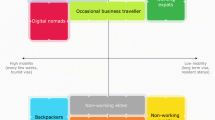Abstract
This paper argues for a linguistic explanation of the nature of Virtual Communities. Virtual Communities develop and grow in electronic space. or ‘cyberspace’. Authors such as Benedikt Meyrowitz and Mitchell have theorised about the nature of electronic space whilst Lefebvre. Popper, Hakim Bey (aka Lamborn Wilson) and Kuhn have theorised more generally about the nature of space. Extending this tradition and the works of these authors, this paper presents a language based perspective on the nature of electronic spaces. Behaviour in cyberspace is based on and regulated by hardware, software tools and interfaces. A definition of electronic space cannot be given beyond its linguistic characteristics, which underlie and sustain it. The author believes that the more users and developers understand the relationship between language and cyberspace, the more they will be able to use specific metaphors for dwelling and inhabiting it. In particular, MUDs/MOOs and the Web are interesting places for testing and observing social behaviours and dynamics.
Similar content being viewed by others
References
Glbson W, Neuromancer. New York: Ace Books. 1984.
Benedikt M. Cyberspace: first steps. Cambridge: MIT University Press. 1991.
Bey H. TAZ. The temporary autonomous zone. Ontological anarchy, poetic terrorism. Brooklyn. New York: Automedia. 1985.
Cicognani A. Verso una nucva virtualita. L'uomo, l'artificiale e al tecnologia. Graduation thesis. Politecnico di Milano, Facoltà di architettura.
Heim M. The metaphysics of virtual reality. New York: Oxford University Press. 1993.
Maldonado T. Reale e virtuale. Milan: Feltrinelli. 1992.
Mitchell W. City of bits. USA: MIT University Press. 1995.
Queau P. Le virtuel. Vertues et vertiges. Paris: INA. 1993.
Rheingold H. The virtual community. London: Martin Secker & Warburg Ltd. 1994.
Clarke AA, et al. A tanguage for cooperation? In: Linguistic Concepts and Methods in CSCW. Connolly H and Pemberton L eds. London: Springer. 1996.
Cassirer E. Philosophie der symbolischen formen, 1er teil: Die Sprache. Berlin: 1923.
Eco U. Le forme del contenuto. Milan: Bompiani, 1971.
Austin JL. How to do things with words. Boston: Harvard University Press. 1962
Novak M. Liquid architectures in cyberspace. In: Cyperspace: first steps. Benedikt M ed. Cambridge: MIT Press. 1992.
Kuhn T. Metaphor in science. In: Metaphor and thought. Ortony A. ed. Cambridge: Cambridge University Press. 1979, 533–542.
Lefebvre H. The construction of space. Translated by Donald Nicholson-Smith. Oxford: Blackwell. 1991.
Popper K. Objective knowledge: an evolutionary approach. Oxford: Oxford University Press. 1972.
Virilio P. Speed and politics: an essay on dromology. Trnaslated by Mark Polizzotti. New York: Colubia University Press. 1986.
Meyrowitz J. No sense of place. The impact of electronic media on social behaviour. New York: Oxford University Press. 1985.
Rucker R, Sirius RU, Mu Q. (eds). MONDO 2000 Users' guide to the new edge. Mondo2000 Publications. 1992.
Cherny L. The modal complexity of speech events in a social MUD. Electronic Journal of Communication. 1995; 5:4
Rushkoff D. Media Virus! Hidden agendas in popular culture. Sydney: Random House 1994.
Juno A. Vale V. Pranks!#11.USA: RE/Search Publications 1987.
Paccagnella L. Sociologia del cyberspazio. La costruziane sociale della realtá sulle reti telematiche. Unpublished dissertation, Universitát degli Studi di Trento.
Stephenson N. Snow crash. New York: Bantam. 1992.
Cicognani A, Maher ML. Design speech acts. How to do things with words in virtual communities. In: CAAD Futures conference proceedings, Munich August 3–6 edited by R. Junge, Kluwer Academic Publishers, 707–717.
Author information
Authors and Affiliations
Corresponding author
Rights and permissions
About this article
Cite this article
Cicognani, A. On the linguistic nature of cyberspace and virtual communities. Virtual Reality 3, 16–24 (1998). https://doi.org/10.1007/BF01409794
Issue Date:
DOI: https://doi.org/10.1007/BF01409794



